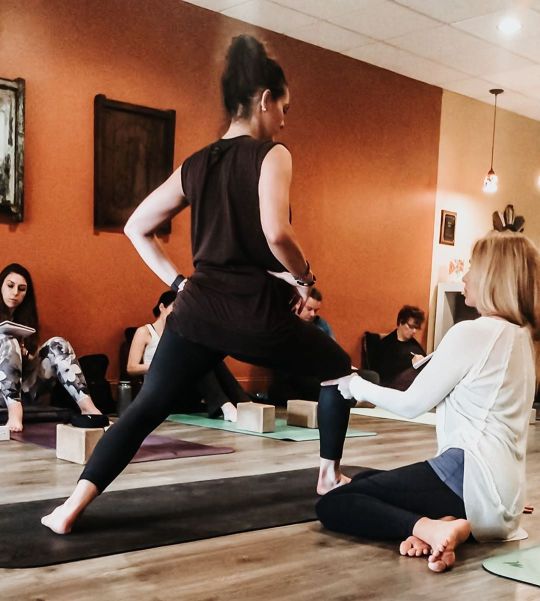#yogacues
Photo

“𝙰 𝚙𝚑𝚘𝚝𝚘𝚐𝚛𝚊𝚙𝚑𝚎𝚛 𝚐𝚎𝚝𝚜 𝚙𝚎𝚘𝚙𝚕𝚎 𝚝𝚘 𝚙𝚘𝚜𝚎 𝚏𝚘𝚛 𝚑𝚒𝚖. 𝙰 𝚢𝚘𝚐𝚊 𝚒𝚗𝚜𝚝𝚛𝚞𝚌𝚝𝚘𝚛 𝚐𝚎𝚝𝚜 𝚙𝚎𝚘𝚙𝚕𝚎 𝚝𝚘 𝚙𝚘𝚜𝚎 𝚏𝚘𝚛 𝚝𝚑𝚎𝚖𝚜𝚎𝚕𝚟𝚎𝚜.” —𝙰𝚝𝚑𝚊𝚗 🙏🏼 𝑯𝒂𝒅 𝒂 𝒋𝒂𝒎 𝒑𝒂𝒄𝒌𝒆𝒅 𝒘𝒆𝒆𝒌𝒆𝒏𝒅 𝒇𝒖𝒍𝒍 𝒐𝒇 𝒚𝒐𝒈𝒂 𝒕𝒆𝒂𝒄𝒉𝒆𝒓 𝒕𝒓𝒂𝒊𝒏𝒊𝒏𝒈 𝒘𝒐𝒓𝒌𝒔𝒉𝒐𝒑𝒔! 𝑴𝒆𝒅𝒊𝒕𝒂𝒕𝒊𝒐𝒏 𝒕𝒚𝒑𝒆𝒔, 𝒂𝒔𝒔𝒊𝒔𝒕𝒔 𝒂𝒏𝒅 𝒂𝒅𝒋𝒖𝒔𝒕𝒎𝒆𝒏𝒕𝒔, 𝒂𝒏𝒂𝒕𝒐𝒎𝒚, 𝒂𝒏𝒅 𝒂 𝒎𝒊𝒅𝒕𝒆𝒓𝒎! 𝑺𝒐 𝒈𝒓𝒂𝒕𝒆𝒇𝒖𝒍 𝒇𝒐𝒓 @gingerboermeester 𝒂𝒏𝒅 𝒕𝒉𝒆 𝒂𝒎𝒂𝒛𝒊𝒏𝒈 𝒕𝒆𝒂𝒄𝒉𝒆𝒓 𝒕𝒓𝒂𝒊𝒏𝒊𝒏𝒈 𝒑𝒓𝒐𝒈𝒓𝒂𝒎 𝒔𝒉𝒆 𝒉𝒂𝒔 𝒄𝒓𝒆𝒂𝒕𝒆𝒅 𝒂𝒏𝒅 𝒑𝒓𝒐𝒗𝒊𝒅𝒆𝒅 𝒂𝒕 @rootsyogaburlington ! 𝑯𝒂𝒍𝒇 𝒘𝒂𝒚 𝒕𝒉𝒆𝒓𝒆!!! ___________________________________________ #yogateachertraining #yogacues #yogaassist #yogaadjustments #ryt200 #yogaalliance #vinyasaflow #yogastrong #yogainstructor #asanas #virabhadrasana #meditationspace #yogapractice #yogapracticenotyogaperfect #200hourteachertraining #sequencing #yogasequence #yogasequencing #mindfulliving #intentionalliving #thejoysquad #longrunpresets (at Roots Yoga Burlington) https://www.instagram.com/p/B7PcnSTBBy5/?igshid=1eyr41y4kabak
#yogateachertraining#yogacues#yogaassist#yogaadjustments#ryt200#yogaalliance#vinyasaflow#yogastrong#yogainstructor#asanas#virabhadrasana#meditationspace#yogapractice#yogapracticenotyogaperfect#200hourteachertraining#sequencing#yogasequence#yogasequencing#mindfulliving#intentionalliving#thejoysquad#longrunpresets
0 notes
Text
What’s the Correct Way to Teach?
It used to be that there was only a slight variation in the way different lineages of yoga were taught. The cues and verbiage may be different, but for the most part the anatomical alignment was very similar. Some movements were discouraged as being detrimental to the safety and alignment of the body.
But over the last few years I am seeing constant changes of thought as to the correct alignment in different postures and the way we move in our practice. I receive articles in my inbox weekly as to new thoughts to age old views on alignment.
As teachers we may have been told to never roll up from a standing forward fold due to the possible compression of the lumbar discs and danger to those suffering from osteoporosis, although I see more and more teachers cuing this movement as being safe.
Encouraging students to stand in alignment, meaning all ten toes facing forward and distributing their weight evenly between the feet, now I receive an article that this may not always be the best alignment cue.
There are different thoughts as to how to cue a seated twist, the safest way to cue Triangle (Trikanasana), or the pelvis alignment in Pyramid pose (Parsvotanasana). Just last week I watched a video by a well-respected yoga teacher on how we as teachers have been correcting the shoulder placement in downdog incorrect all these years.
I have been teaching yoga for 17 years now, and every week I am asked (via yoga articles and videos) to re-think everything I have been taught. It seems it is no longer just a slight variation from lineage to lineage, but instead an overall change in the way we look at anatomy and its impact on yoga postures.
For a while I have been letting this drive me crazy, trying to keep up with all this new advice and trying to change and adjust to new ways of practicing and cuing. I keep thinking that many advanced teachers are coming to have a greater understanding of the human body and kinesiology, so they must be right, but is this always so? Do we understand so much more than the teachers that have come before us, B.K.S. Iyengar, Pattabhi Jois, Krisnamacharya?
I’ve come to realize that there isn’t a one size fits all cue. While I may not cue my students to roll up from a forward fold, that isn’t to say it wouldn’t be safe or comfortable for some.
Each time I encounter a ‘new way of thinking’ in regards to the alignment in a posture, I’m going to try it and see how it fits with my body, to understand the alignment anatomy behind the change and determine if it makes sense both physically and mentally to make the change.
I may be cuing some postures differently than I did before, I may stop using certain cues, and I may stick with many of the tried and true cues. All I can do is my best for my students, try and keep them safe, offer them options and let them decide what works for their body’s.
#yoga yogaanatomy yogacues yogalineages bksiyengar pattabhijois krisnamacharya kinesiology alignment
1 note
·
View note
Photo

“It totally changes your experience of what you’re doing, what you’re noticing as you do it — simply in the act of turning your head. How differently my body feels when I turn my head, when I also get information from over here! Once you decide on a direction, it edits what you see, what you perceive.” Gotta love Deborah Hay. Would this cue work in a yoga class? 🤔🤣 #yoga #yogacues #yogajourney #yogaeverywhere #fuckinghead #contemporarydance (at Independent Dance)
0 notes
Text
Visualization Technique: Breathing Into Certain Muscles
#yoga #yogaeverydamnday #beginner #breath #breathe #muscle #muscles #cue #yogacue #visualise #visualize

Breathing into certain muscles to go deeper into a pose is a common cue yoga instructors give. What exactly does that mean, though? How does one breath into anywhere other than the lungs? First, you should be able to visualize your breath at a normal breathing rate; give it a colour, make it visible to your mind’s eye. I imagine this would be easier for smokers, since they’re used to actually…
View On WordPress
#asana#beginner#breath#breathe#cue#cues#explanation#improvement#inspiration#motivation#muscle#pose#self#visual#visualisation#visualise#visualization#visualize#yoga
0 notes